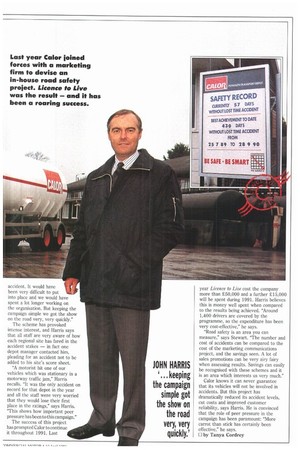CAMPAIGN FORS
Page 40

Page 41

If you've noticed an error in this article please click here to report it so we can fix it.
• Calor has always been proud of its fleet's safety record. But operations director John Harris insists that such records can always be improved — and in the past 12 months he has managed to reduce vehicle accidents by 20%.
This has been achieved through training programmes and an internal marketing scheme. For the past three years Calor has been running a workplace safety programme called Countdown to Safety which in 1989 cut accidents by half.
This success prompted Harris to consider extending a similar scheme to Calor's transport divisions. The firm runs a fleet of 800 HGVs, 200 light commercials and 500 company cars. Transport is divided into two sections: Calor Gas, the firm's in-house operations; and Calor Transport, a third-party distributor which works mainly for outside companies.
Harris approached Project Link, the marketing firm involved in Countdown to Safety, and asked it to produce a road safety campaign. The scheme was devised and implemented within six months.
Bruce Stewart, sales director for Project Link, says his team decided on a wide range of activities. The first step was the installation of a new accident recording system. Each transport depot keeps brief accident details and submits them to Calor's Slough headquarters every month. Through this procedure Harris could start to build up a national picture of safety levels.
The next stage was the launch of an in-house safety campaign, complete with literature and a logo. Accident boards were issued to all transport sites so Calor staff — whether company car drivers or HGV Class One holders — can see how their depot ranks in accident levels.
COMPETITIONS
This Licence to Live campaign also includes quarterly competitions. Booklets are distributed to drivers with road safety quizzes. These are then handed in and the results analysed together with the accident record sheets. The regions with the lowest accident rate and best competition results win an award.
An annual trophy — a massive wooden steering wheel — is presented to the transport depot with the best overall performance during the year, and general safety and Highway Code leaflets are regularly distributed to Calor's staff.
The third stage of the campaign was the launch of a hi-tech training video. Computer equipment was bought which allows Calor staff to "drive" an HGV simulator. The inter-active video, originally developed by Shell (CM 31 August-6 September 1989) and now handled by Interactive Information Systems at nearby Langley, throws numerous hazards at the drivers, whose reactions are monitored by the computer.
Calor has launched a programme to test all its drivers with this equipment. Simulators have been installed in all six regional depots as well as in its headquarters.
Harris is extremely pleased with the success and effectiveness of the campaign. Excellent results have been achieved through one basic principle, he says: "Keep it simple."
"Under Licence to Live all accidents are counted — regardless of who is at fault," says Harris. "The whole scheme would have been very different if the statistics had been based on who was at fault in an accident. It would have been very difficult to put into place and we would have spent a lot longer working on the organisation. But keeping the campaign simple we got the show on the road very, very quickly."
The scheme has provoked intense interest, and Harris says that all staff are very aware of how each regional site has fared in the accident stakes — in fact one depot manager contacted him, pleading for an accident not to be added to his site's score sheet.
"A motorist hit one of our vehicles which was stationary in a motorway traffic jam," Harris recalls. "It was the only accident on record for that depot in the year and all the staff were very worried that they would lose their first place in the ratings," says Harris. "This shows how important peer pressure has been to this campaign."
The success of this project has prompted Calor to continue it throughout 1991. Last
year Licence to Live cost the company more than £50,000 and a further £15,000 will be spent during 1991. Harris believes this is money well spent when compared to the results being achieved. "Around 1,400 drivers are covered by the programme, so the expenditure has been very cost-effective," he says.
"Road safety is an area you can measure," says Stewart. "The number and cost of accidents can be compared to the cost of the marketing communications project, and the savings seen. A lot of sales promotions can be very airy fairy when assessing results. Savings can easily be recognised with these schemes and it is an area which interests us very much."
Calor knows it can never guarantee that its vehicles will not be involved in accidents. But this project has dramatically reduced its accident levels, cut costs and improved customer reliability, says Harris. He is convinced that the role of peer pressure in the campaign has been paramount: "More carrot than stick has certainly been effective," he says.












































































































